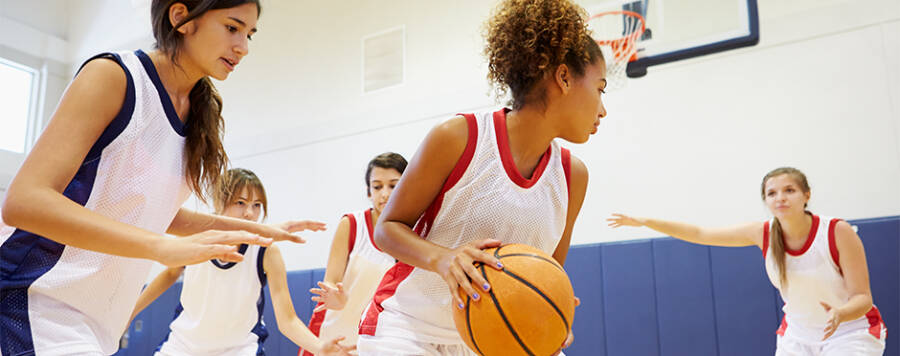1. Don’t skip the warm-up or cool down
Completing a dynamic warm-up before practice or a game is vital to a return to play. Warming up helps prepare your body for the activities it is about the perform playing your sport. There is some research to suggest dynamic warm-ups help prevent injury1. Types of dynamic warm-up may vary depending on the sport. Examples include walking lunges, high knees, butt kicks, hip openers, and torso twists. Overhead athletes should be sure to incorporate arm warm-ups in addition to lower body stretches.
After exercise, static stretching can help with flexibility gains2. Flexibility is also important for injury prevention. A good stretching session after practice can also be a good cool down to help with muscle recovery. Make sure to include this when you return to sports.
2. Start back at a manageable level
After any break in activity level, you should plan to start back at a lower level than where you previously were. This means easing back into workouts- fewer reps, lighter resistance, or a shorter workout duration initially. It would be best if you planned to start lower to assess how you feel upon returning to your sport. This initial adjustment period can help you prevent an injury rather than trying to return too quickly.
3. Hydrate
Athletes should drink water before, after, and during practice (every 15-20 minutes). Sports drinks are ok to drink but no better than water unless exercising for more than 60-90 minutes in really hot weather. Do not drink energy drinks before exercise. Caffeine is a diuretic that can make you dehydrated.
4. Sleep3
Your sleep schedule may have changed during the summertime, but kids between 13-18 years old generally need 8-10 hours of sleep each night and athletes may need 9-11 hours. Make sure you are going to bed at an adequate time to wake up before practice the next day. A sleep extension study conducted on basketball players found that increasing sleep to 10 hours per night led to improvements in reaction time, sprint time, shooting accuracy, daytime sleepiness, and overall mood3. Student-athletes who regularly sleep less than eight hours a night are 1.7 times more likely to sustain an injury3. Studies on short-term and long-term sleep deprivation propose that sleep deprivation lowers endurance in runners, cyclists, and weightlifters. Sleep-deprived athletes subjectively tire faster and find it more of an effort to complete tasks. In summary, make sure you get those zzz’s!
5. Listen to your body
Make sure you listen to your body when returning to sports. Try not to push through pain; pain is your body’s way of telling you something. Rest is also an important part of a return to sports, so make sure to have rest days or active recovery between practice. Full rest may not be necessary but make sure to listen to your body regarding the number of reps or the number of skills being performed at practice or games.
Return to School and Sports Safely
Hopefully, you enjoyed your summer break but now that it’s time to go back to school and sports, use these tips to return as safely as possible. If you are experiencing pain, schedule a free assessment. Free assessments are available in-clinic and virtually through our telehealth platform.
*Per federal guidelines, beneficiaries of plans such as Medicare, Medicaid, Tricare, VHA and other federally funded plans are not eligible for free assessments.
The Athletico blog is an educational resource written by Athletico employees. Athletico bloggers are licensed professionals who abide by the code of ethics outlined by their respective professional associations. The content published in blog posts represents the opinion of the individual author based on their expertise and experience. The content provided in this blog is for informational purposes only, does not constitute medical advice and should not be relied on for making personal health decisions.
References:
1. Woods K, Bishop P, Jones E. Warm-up and stretching in the prevention of muscular injury. Sports Med. 2007;37(12):1089-99. doi: 10.2165/00007256-200737120-00006. PMID: 18027995.
2. Page P. Current concepts in muscle stretching for exercise and rehabilitation. Int J Sports Phys Ther. 2012 Feb;7(1):109-19. PMID: 22319684; PMCID: PMC3273886.
3. Sleep Foundation. https://www.sleepfoundation.org/teens-and-sleep/student-athletes-sleep-time
About the Author:
Tara Hackney, a physical therapist in Marion, IA, enjoys working with all patient types, especially gymnasts, cheerleaders, and dancers. She is the prominent blogger for Athletico's Gymnastic/Cheer Program. With an orthopedic specialization and training in dry needling and Graston technique, Tara hopes to answer your questions about injuries and injury prevention in an easy-to-understand manner. She hopes to ease fears surrounding pain and injuries, address concerns about recovery, and provide tips to prevent injury. In her free time, she enjoys spending time with her dog, reading, and watching her nephews play sports.

 width="900"
height="356"
>
width="900"
height="356"
>
